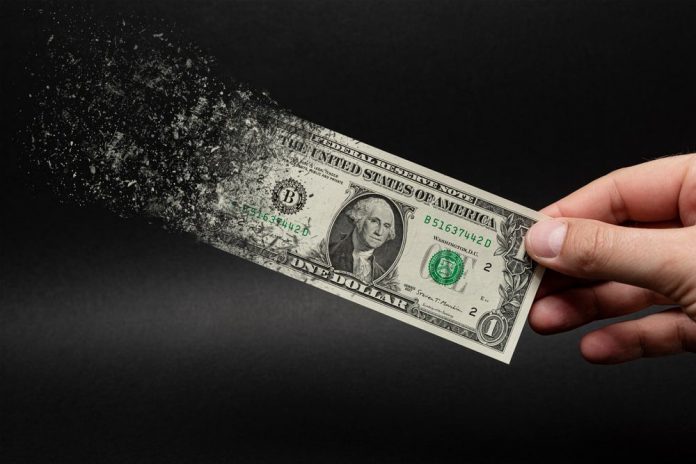INVesting
Inflation is an ever-present part of modern economic life. But its effects often are modest and relatively unnoticed, especially over short periods of time.
When that changes, however, it changes in a hurry, and in a big way. Economic participants need to adapt quickly.
To do that, they need to understand what inflation is, what its impacts are — and how to respond to inflation
Inflation Definition
Technically speaking, inflation is the rate of increase in prices over a specific period of time. Colloquially, however, the term “inflation” most commonly is used in reference to the rate of increase in the Consumer Price Index for All Urban Consumers, usually referred to as the Consumer Price Index or simply the CPI.
That said, inflation measures don’t require the CPI. The same federal agency that compiles the CPI, the Bureau of Labor Statistics, also tracks the Producer Price Index, or PPI. The PPI tracks the rate of increase in prices achieved by domestic producers; the CPI tracks the rate of increase in prices paid by domestic consumers.
Inflation can be used without an index as well. Inflation can be measured in a specific commodity and/or market. Companies might refer to the increase in their costs as inflation; “wage inflation”, in particular, is a common term covering the change in labor expense.
Again, on a technical basis, inflation refers to any increase in almost any price. But in political and even economic commentary, inflation almost always refers to the rate of change in the CPI.
Inflation Rate Formula
The basic formula for calculating the inflation rate follows the same framework as any other percentage-based comparison. The inflation rate is equal to the change of prices divided by the original base.
For annual inflation, for instance, the formula would look like this:
\cfrac{\text{(Price Or Index At Present) – (Price Or Index 1 Year Ago)}} {\text{(Price 1 Year Ago)}}Expressed as a percentage change
For instance, the CPI in June 2022 was 296.311. A year before, the figure was 271.696. So our calculation is as follows:
\cfrac{\text{((296.311 – 271.696)}} {\text{(271.696)}}Or 1.091. To put that figure into percentage, we subtract 1, to get .091, and then multiply by 100, to reach the 9.1% reported figure.
As far as the Consumer Price Index goes, there’s an obvious question: how is the CPI calculated? It’s a complex process. The BLS surveys thousands of Americans every quarter to understand spending patterns. It also records the prices of some 80,000 items every month.
Quite obviously, the method is not replicable. And it’s worth noting that the BLS method creates some controversy, and no doubt has some flaws.
Among the issues is the fact that CPI measures a fixed basket of goods over time — yet those goods constantly improve. This is most obvious in electronics. Adjusted for rises in CPI, televisions and personal computers have fallen in price over the past two decades — yet both products offer substantially better experiences for their owners than they did 20 years ago. The CPI, however, treats a personal computer in 2022 the same way it did in 2002.
Another is that short-term shocks can significantly impact the CPI, in particular. Natural disasters can spike gas or food prices, and those prices can reverberate throughout the economy. Economists and government officials thus often focus on “core CPI,” which excludes those changes.
The CPI is not perfect — and so our most common measure of inflation isn’t perfect, either. That doesn’t mean inflation is a “fake” figure or without utility. Rather, it’s a single metric that aims to cover purchasing behavior in the world’s largest economy. The ability to create that metric by nature incorporates trade-offs and even compromises.
What Are The Types Of Inflation?
Inflation is broken into different categories based on its rate of change. The three most common types of inflation are:
- “Creeping” inflation
- “Walking” inflation
- “Galloping” inflation
In the U.S., “creeping” inflation, referred to as a rise of 3% a year or less, has been the default condition for most of the last four decades. Creeping inflation generally exists at a level where its impact on the broader economy and on consumer choices is relatively small.
The next level up, with inflation between 3% and 10%, is known as “walking” inflation. At this point — depending on the specific products seeing higher prices — inflation concerns can become more noticeable. Wage increases may struggle to keep up, leading to real (ie, inflation-adjusted) wages that actually decline over time..
Above 10%, inflation is “galloping” — and concerning. This is an uncommon condition for the U.S.: the last year with galloping inflation for the full year was 1981.
Stagflation, Hyperinflation, Deflation, and Disinflation
Generally speaking, inflation accompanies economic growth. But that’s not always the case, as the last bout of galloping inflation in the U.S. shows.
In the late 1970s and early 1980s, the U.S. economy suffered from what was termed as “stagflation”. Inflation was high — above 10% not only in 1981, but the two previous years — yet economic growth was also relatively stagnant.
Stagflation thus offers a brutal combination. Purchasing power declines — yet neither wages nor assets rise much, if at all. The result is a quick and substantial move downward in living standards.
But even stagflation isn’t as painful as hyperinflation. Hyperinflation traditionally has been defined as an inflation rate above 50% per month, or roughly 13,000% per year. (Monthly inflation rates compound; a 50% monthly rate for 12 months is equal to 1.512, or 12,975%.)
Hyperinflation is an exceptionally rare occurrence. It occurred, for instance, in the Weimar Republic of 1920s Germany. More recently, Zimbabwe in the late 2000s saw hyperinflation so intense that at one point it issued a one hundred trillion dollar note
Once confidence in the currency collapses completely, there’s in essence no brake left on hyperinflation. Consumers and producers spend money received as fast as possible, since the currency devalues literally by the day. This creates a vicious cycle of faster spending, even higher inflation, and so on.
To be sure, high inflation isn’t the only potential source of danger. A negative inflation rate, referred to as deflation, can cause its own problems. In a deflationary environment, prices actually fall year-over-year.
Deflation is a rare occurrence in the U.S., though the CPI did contract year-over-year during the early part of the novel coronavirus pandemic. It’s a good thing that deflation is rare: steadily declining prices can create a spiral analogous to that of hyperinflation, but in reverse.
When deflation occurs, consumers slow spending because they believe prices will be cheaper later. This forces producers to cut prices to account for lower demand. Spending has slowed, and producer profits have been cut; this in turn drives economic contraction which drives even slower consumer spending. Further deflation follows, and the vicious spiral continues.
Disinflation, however, is not deflation. Rather, disinflation refers to a negative rate of change in the inflation rate. If, for example, inflation moves from 6% to 3%, it can be said that disinflation is occurring.
What Causes Inflation?
Broadly speaking, there are three causes of inflation.
- Demand-pull inflation occurs when demand exceeds supply, causing prices to rise.
- In cost-push inflation, producers instead have to pass along their own higher prices; for example, if the price of steel increases, so does the price of a finished automobile.
- There’s also the so-called “wage-price spiral”, also known as built-in inflation. As prices rise, workers expect their wages to do the same. Those higher wages increase demand, which increases overall prices, which in turn leads more workers to demand more wages.
There is another potential cause of inflation, though it might also be interpreted as another definition of inflation. One common description of demand-pull inflation is “too much money chasing too few goods,” and some observers would argue that the U.S. Federal Reserve on occasion “creates” too much money.
Low short-term interest rates boost the money supply in a bid to drive economic growth; too much growth, however, can lead to demand-pull inflation. Historically, the Fed has then responded by raising short-term rates, cooling off inflation — and, almost always, the economy with it.
Why Is Inflation So High?
In the early 1980s, former Federal Reserve chairman Paul Volcker famously “broke” a long-lasting period of inflation by hiking interest rates to nearly 20 percent. From that point on, US consumers had little cause to think much about inflation, which usually topped out in the 3-4% range.
In the post-pandemic era, that changed. Higher oil prices driven by the Russian invasion of Ukraine echoed throughout the economy, spiking the cost of transporting items. Supply-chain snarls driven by the pandemic were amplified by a focus on “just-in-time” manufacturing, which left minimal inventory and minimal cushion to manage through delays.
Of course, those were far from the only factors. The accommodative policy from the Fed led to a boom in asset prices, lending, and consumer spending, driving demand-pull inflation. Commodity prices beyond oil spiked, adding cost-push inflation to the mix. A tight labor market added a wage-price spiral. Some observers would even blame fiscal stimulus from the federal government in 2021 for pouring gasoline on the proverbial fire.
To some degree, all of these factors are at play. Which factor was the most important is up for debate.
Consequences of Inflation
Inflation has a negative connotation, and it does have negative effects. But the consequences of inflation are a mixed bag.
The most obvious and direct negative consequence is that inflation reduces purchasing power. As prices rise, a dollar simply doesn’t go as far. In an environment where increases in wages aren’t keeping pace with the increases in goods and services, living standards can actually decline.
But there are beneficial aspects of inflation — for certain groups. Those in debt, whether individuals or governments, get a boost from inflation. The value of the debt is fixed; the value of the currency in which that debt is denominated, however, is falling.
To be sure, these pluses and minuses occur in the case of relatively modest inflation. When inflation hits a dizzying rate, it alone can crush the economy, simply because the participants in the economy literally aren’t sure what to do. It’s impossible to negotiate a price when that price might be out of date in two weeks.
How To Hedge Against Inflation
There are a number of investments that traditionally are touted as inflation hedges.
One of the most notable is gold. On its face, this argument makes some sense. Gold holds its value; in an inflationary scenario, the local currency loses its value. Thus, over an inflationary period, the price of gold in that local currency should rise, offsetting the impact of the inflation in that currency.
The problem is that history doesn’t necessarily bear that argument out. Gold instead may be a hedge against uncertainty and/or a weak equity market — two conditions that often (though not always) are accompanied by inflation.
A more classic, and historically more effective, hedge is real estate. Home ownership offers protection from rising rental expense (and, as noted above, can offer the added benefit if the home is funded by a fixed-rate mortgage). That aside, owned residential or commercial properties benefit from inflation through rising rents and thus higher values.
Of course, executing these hedges in a manner that can offset inflation requires a relatively significant amount of capital. It’s why inflation is often referred to as a tax on the poor. Those with lower incomes see a greater share of that income lost to higher prices.
Advantages and Disadvantages of Inflation and Deflation
Inflation generally has a negative connotation. Indeed, there are downsides to inflation, even at modest levels.
The most obvious and direct negative consequence is that inflation reduces purchasing power. As prices rise, a dollar simply doesn’t go as far. In this scenario, “real” wages — money paid to workers adjusted for the reduced purchasing power of the money — are declining. Living standards thus are reduced: a worker might have a higher salary in her local currency, yet in fact her overall purchasing power has been reduced.
This has a potential broader social consequence as well, as inflation can exacerbate income inequality. As we’ll discuss later, one way to hedge against inflation is to own real assets — notably real estate. In theory, asset prices should rise to match inflation, but those without assets, most notably renters, don’t have access to that hedge.
But not every aspect of inflation is negative. There are beneficial aspects of inflation — for certain groups. Those in debt, whether individuals or governments, get a boost from inflation. The value of the debt is fixed; the value of the currency in which that debt is repaid, however, is falling. This in fact is one reason why some economists fret about government debt: the theory is that unsustainable debt inevitably will lead to high inflation, as “inflating away the debt” is the only way in which government borrowings will be repaid.
Meanwhile, some level of inflation is almost certainly a net positive for the economy. Again, a deflationary cycle is particularly dangerous: if the local currency will be worth more in the future, it’s exceptionally difficult to get consumers to spend. A manageable level of inflation avoids this trap.
To be sure, these pluses and minuses occur in the case of relatively modest inflation. When inflation hits a dizzying rate, it alone can crush the economy, simply because the participants in the economy literally aren’t sure what to do. It’s impossible to negotiate a price when that price might be out of date in two weeks.
Controlling Inflation
As the example of the Federal Reserve under Paul Volcker shows, one way to control inflation is to raise interest rates. Higher central bank interest rates lead to higher interest on debt across the economy.
As a result, consumers are less likely to finance purchases, since it is now more expensive to do so. The pace of business borrowing slows for the same reason. The impact of decisions by both groups reduces demand-pull inflation, which in turn should drive disinflation.
That’s far from the only method, however. During the 2008 financial crisis, the Fed and other central banks embarked on a program known as “quantitative easing”. QE, as it is often called, entails purchasing securities in the open market to lower interest rates once central bank interest rates already have reached or neared zero. This injects more capital into the economy, hopefully juicing economic activity, while central bank balance sheets grow.
To attack inflation, QE can be reversed, a strategy known as “quantitative tightening”, or QT for short. Under QT, central banks sell assets of their balance sheets or let bonds mature and recapture the principal. Cash thus is pulled out of the economy and into central banks, potentially reducing the problem of “too much money chasing too few goods.”
But it’s important to remember that monetary policy is not the only way to fight inflation. Fiscal measures can help as well.
Higher taxes — whether through direct rate increases or changes in the tax code — slow economic activity and in turn inflation. Reducing budget deficits and/or lowering overall debt keeps the government from adding to demand, either through its own spending or through transfer payments to businesses or consumers.
Economic participants can also do their part. Higher productivity, in which goods are produced more efficiently, usually leads to reduced inflation. More productive enterprises create more goods at the same or lower unit cost. That in turn adds to supply, which reduces upward pressure on prices.




